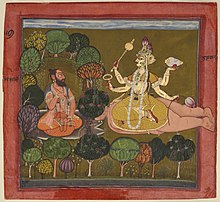
Back Brahmaan Afrikaans Polomen AMI براهمة Arabic براهمين ARZ Brahmanlar Azerbaijani Brahmin BCL Брахманы Byelorussian ব্রাহ্মণ (বর্ণ) Bengali/Bangla Bramans Catalan Bráhman Czech
| Part of a series on |
| Hinduism |
|---|
 |

Brahmin (/ˈbrɑːmɪn/; Sanskrit: ब्राह्मण, romanized: brāhmaṇa) is a varna as well as a caste within Hindu society. The other three varnas are the Kshatriya, Vaishya, and Shudra.[1][2][3][4][5] The traditional occupation of Brahmins is that of priesthood (purohit, pandit, or pujari) at Hindu temples or at socio-religious ceremonies, and the performing of rite of passage rituals, such as solemnising a wedding with hymns and prayers.[6][7]
Traditionally, Brahmins are accorded the highest ritual status of the four social classes,[8] and they also served as spiritual teachers (guru or acharya). In practice, Indian texts suggest that some Brahmins historically also became agriculturalists, warriors, traders, and had also held other occupations in the Indian subcontinent.[7][8][9]

- ^ Benjamin Lee Wren (2004). Teaching World Civilization with Joy and Enthusiasm. University Press of America. pp. 77–. ISBN 978-0-7618-2747-4.
At the top were the Brahmins(priests), then the Kshatriyas(warriors), then the vaishya(the merchant class which only in India had a place of honor in Asia), next were the sudras(farmers), and finally the pariah(untouchables), or those who did the dirty defiling work
- ^ Kenneth R. Valpey (2 November 2019). Cow Care in Hindu Animal Ethics. Springer Nature. pp. 169–. ISBN 978-3-03-028408-4.
The four varnas are the brahmins (brahmanas—priests, teachers); kshatriyas (ksatriyas—administrators, rulers); vaishyas (vaisyas—farmers, bankers, business people); and shudras(laborers, artisans)
- ^ Richard Bulliet; Pamela Crossley; Daniel Headrick; Steven Hirsch; Lyman Johnson (11 October 2018). The Earth and Its Peoples: A Global History, Volume I. Cengage Learning. pp. 172–. ISBN 978-0-357-15937-8.
Varna are the four major social divisions: the Brahmin priest class, the Kshatriya warrior/ administrator class, the Vaishya merchant/farmer class, and the Shudra laborer class.
- ^ Akira Iriye (1979). The World of Asia. Forum Press. p. 106. ISBN 978-0-88273-500-9.
The four varna groupings in descending order of their importance came to be Brahmin (priests), Kshatriya (warriors and administrators), Vaishya (cultivators and merchants), and Sudra (peasants and menial laborers)
- ^ Cite error: The named reference
ludo14was invoked but never defined (see the help page). - ^ James Lochtefeld (2002), Brahmin, The Illustrated Encyclopedia of Hinduism, Vol. 1: A–M, Rosen Publishing, ISBN 978-0-8239-3179-8, page 125
- ^ a b GS Ghurye (1969), Caste and Race in India, Popular Prakashan, ISBN 978-81-7154-205-5, pages 15–18
- ^ a b Doniger, Wendy (1999). Merriam-Webster's encyclopedia of world religions. Springfield, MA, US: Merriam-Webster. pp. 141–142, 186. ISBN 978-0-87779-044-0.
- ^ David Shulman (1989), The King and the Clown, Princeton University Press, ISBN 978-0-691-00834-9, page 111